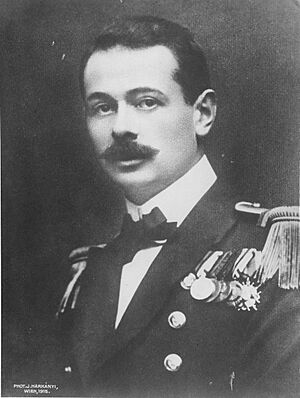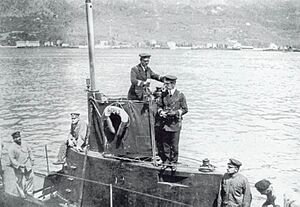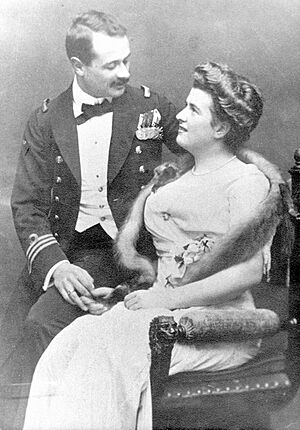Georg von Trapp facts for kids
Quick facts for kids
Georg von Trapp
|
|
|---|---|
 |
|
| Born | 4 April 1880 Zara, Kingdom of Dalmatia, Austria-Hungary (Zadar, Croatia)
|
| Died | 30 May 1947 (aged 67) Stowe, Vermont, U.S.
|
| Resting place | Trapp Family Cemetery, Trapp Family Lodge, Stowe, Vermont |
| Nationality | Austrian; Italian |
| Spouse(s) |
Agathe Whitehead
(m. 1911; died 1922)Maria Augusta Kutschera
(m. 1927) |
| Children | 10, including Agathe, Maria Franziska, and Johannes |
| Military career | |
| Allegiance | Austria-Hungary |
| Service/ |
Austro-Hungarian Navy |
| Years of service | 1898–1918 |
| Rank | Korvettenkapitän (lieutenant-commander) |
| Commands held |
|
| Battles/wars | Boxer Rebellion World War I |
| Awards | Knight's Cross of the Military Order of Maria Theresa (1924) |
Georg Ludwig Ritter von Trapp (born April 4, 1880 – died May 30, 1947) was a brave officer in the Austro-Hungarian Navy. He later became the father of the famous Trapp Family Singers, whose story inspired the musical The Sound of Music.
During World War I, Trapp was a very successful submarine commander. He sank 11 enemy merchant ships and two warships. Because of his amazing achievements, he received many awards, including the Military Order of Maria Theresa.
His first wife, Agathe Whitehead, passed away in 1922 from scarlet fever, leaving behind seven children. Trapp then hired Maria Augusta Kutschera to teach one of his daughters. He and Maria married in 1927.
Later, the family lost most of their money during the Great Depression. To earn a living, they started singing together. When Nazi Germany took over Austria in 1938, Trapp refused to join the German Navy. He and his family then moved to the United States.
After his death in 1947, the family's home in Vermont became the Trapp Family Lodge. Maria von Trapp's book, The Story of the Trapp Family Singers, was made into a German film. This film then became the basis for the well-known musical The Sound of Music and the 1965 movie.
Contents
Early Life and Family Beginnings
Georg Ludwig Ritter von Trapp was born in a place called Zara, which is now Zadar, Croatia. At that time, it was part of the Austro-Hungarian Empire. His father, August Johann Trapp, was also a naval officer. He was given the title Ritter von Trapp (which means Knight of Trapp) because of his achievements. Georg and his brother inherited this special title. Georg's father died when Georg was only four years old.
Georg's mother was Hedwig Wepler. He had an older sister, Hede von Trapp, who became an artist. His brother Werner sadly passed away during World War I.
In 1894, when Georg was 14, he followed his father's path and joined the Austro-Hungarian Navy. He went to a naval academy in Fiume (now Rijeka). All naval students had to learn a musical instrument, and Georg chose the violin. After four years, he graduated and spent two more years training on ships, even sailing to Australia. On his way home, he visited the Holy Land and bought seven bottles of water from the Jordan River. He later used this water to baptize his first seven children.
In 1900, he served on a ship called SMS Zenta. He was recognized for his bravery during the Boxer Rebellion in China. In 1908, he became very interested in submarines and joined the navy's new submarine division. He was promoted and, in 1910, became the commander of a new submarine, SM U-6.
World War I Heroics
On April 17, 1915, Trapp took command of another submarine, SM U-5. He went on nine combat missions in U-5 and sank two enemy warships. One was a French armored cruiser, Léon Gambetta, which he sank at night. This was a big achievement because it was one of the first successful underwater night attacks by a submarine. Later, he also sank an Italian submarine, Nereide.
Trapp then moved to command SM U-14, which was a French submarine that the Austro-Hungarian Navy had captured and repaired. In this larger submarine, he focused on attacking merchant ships instead of warships. Between April and October 1917, U-14 sank 11 Allied merchant ships under his command.
In May 1918, he was promoted to Korvettenkapitän (which is like a lieutenant commander). He was put in charge of the submarine base at Cattaro. However, World War I ended, and the Austro-Hungarian Empire broke apart. Austria became a landlocked country without a navy, which ended Trapp's naval career.
Impressive War Record
Georg von Trapp's missions in U-5 and U-14 made him the most successful Austro-Hungarian submarine commander of World War I. He sank 11 Allied merchant ships and two Allied warships.
| Date | Vessel | Nationality | Outcome |
|---|---|---|---|
| 27 April 1915 | Léon Gambetta | Sunk | |
| 5 August 1915 | Nereide | Sunk | |
| 29 August 1915 | Cefalonia | Captured |
| Date | Vessel | Nationality | Location |
|---|---|---|---|
| 28 April 1917 | Teakwood | 36°39′N 21°10′E / 36.650°N 21.167°E | |
| 3 May 1917 | Antonio Sciesa | 36°39′N 21°15′E / 36.650°N 21.250°E | |
| 5 July 1917 | Marionga Goulandris | 35°38′N 22°36′E / 35.633°N 22.600°E | |
| 23 August 1917 | Constance | 36°51′N 17°25′E / 36.850°N 17.417°E | |
| 24 August 1917 | Kilwinning | 35°26′N 16°30′E / 35.433°N 16.500°E | |
| 26 August 1917 | Titian | 34°20′N 17°30′E / 34.333°N 17.500°E | |
| 28 August 1917 | Nairn | 34°05′N 19°20′E / 34.083°N 19.333°E | |
| 29 August 1917 | Milazzo | 34°44′N 19°16′E / 34.733°N 19.267°E | |
| 18 October 1917 | Good Hope | 35°53′N 17°05′E / 35.883°N 17.083°E | |
| 18 October 1917 | Elsiston | 35°40′N 17°28′E / 35.667°N 17.467°E | |
| 23 October 1917 | Capo Di Monte | 34°53′N 19°50′E / 34.883°N 19.833°E |
Awards and Decorations
Georg von Trapp received many honors for his service, including:
- Knight's Cross of the Military Order of Maria Theresa (1924)
- Knight 2nd Class of the Order of the Iron Crown (1917)
- Iron Cross 1st and 2nd Class (from Germany)
Family Life and the Trapp Family Singers
Georg von Trapp married Agathe Gobertina Whitehead. Agathe's grandfather, Robert Whitehead, invented the modern torpedo. Agathe's family was wealthy, which helped Georg and Agathe start their family. They had seven children together: Rupert, Agathe, Maria Franziska, Werner, Hedwig, Johanna, and Martina.
Sadly, Agathe von Trapp passed away in 1922 from scarlet fever. Georg then moved his family to a new home in Salzburg, Austria.
Second Marriage and New Beginnings
Around 1926, Georg hired Maria Augusta Kutschera, a young woman from a nearby abbey, to tutor his daughter Maria Franziska, who was recovering from an illness. Georg and Maria Augusta fell in love and married on November 26, 1927. He was 47, and she was 22. They had three more children: Rosmarie, Eleonore, and Johannes.
From Wealth to Music
In 1935, the Trapp family lost most of their money. Georg had invested his inherited wealth in an Austrian bank, but the bank failed during the Great Depression. This meant the family needed a new way to earn money.
Around this time, a priest named Franz Wasner helped the children with their music. In 1936, a famous singer named Lotte Lehmann heard the family sing and suggested they perform concerts for money. When the Austrian leader, Kurt von Schuschnigg, heard them on the radio, he invited them to perform in Vienna. Father Wasner became their musical director.
Leaving Austria for Freedom
After Nazi Germany took over Austria in 1938 (an event called the Anschluss), Georg von Trapp faced a difficult choice. He was offered a position in the German Navy. Even though the new submarines were impressive, Trapp strongly disagreed with Nazi ideology and refused the offer. He also politely declined a request for his family choir to sing at Adolf Hitler's birthday concert.
When his oldest son also decided to refuse a medical job that had fired Jewish doctors, Georg realized they were in danger. He told his children they had to choose between a comfortable life under the Nazis or becoming refugees to keep their honor. The Trapp family bravely decided to leave Nazi Austria.
The Trapps traveled by train to Italy, not over the mountains to Switzerland as shown in The Sound of Music. They had a contract with an American booking agent. From Italy, they went to London and then sailed to the United States for their first concert tour.
In 1939, the family returned to Europe to tour Scandinavia, hoping to avoid the reach of the Nazis. They briefly visited Salzburg before returning to Sweden and then traveling to Norway to head back to the United States in September 1939, just as World War II began.
After living briefly in Pennsylvania, where their youngest child, Johannes, was born, the family settled in Stowe, Vermont, in 1941. In 1942, they bought a large farm and turned it into the Trapp Family Lodge. After World War II, the Trapp family helped the people of Austria by founding the Trapp Family Austrian Relief, Inc., with Father Wasner as its treasurer.
Death
Georg von Trapp passed away on May 30, 1947, in Stowe, Vermont, from lung cancer. His wife, Maria, wrote in her book that many World War I submarine crews developed lung cancer due to diesel fumes and poor air in the submarines. She also mentioned that he was a heavy smoker, which was common at the time.
Georg von Trapp's Children
| Image | Name | Mother | Birth | Death | Notes |
|---|---|---|---|---|---|
| Rupert | Agathe Gobertina née Whitehead | 1 November 1911 | 22 February 1992 (aged 80) | He became a doctor. | |
 |
Agathe | 12 March 1913 | 28 December 2010 (aged 97) | She was a singer and artist. | |
 |
Maria Franziska | 28 September 1914 | 18 February 2014 (aged 99) | She worked as a singer and missionary. | |
| Werner | 21 December 1915 | 11 October 2007 (aged 91) | He married Erika Klambauer and had six children, including singer Elisabeth von Trapp. | ||
 |
Hedwig | 28 July 1917 | 14 September 1972 (aged 55) | She was a teacher. | |
 |
Johanna | 7 September 1919 | 25 November 1994 (aged 75) | She married Ernst Florian Winter and had seven children. | |
 |
Martina | 17 February 1921 | 25 February 1951 (aged 30) | She passed away during childbirth. | |
| Rosmarie | Maria Augusta von Trapp née Kutschera | February 8, 1929 | 13 May 2022 (aged 93) | Rosmarie was a singer and missionary. | |
| Eleonore | May 14, 1931 | 17 October 2021 (aged 90) | She married Hugh David Campbell and had seven daughters. | ||
| Johannes | 17 January 1939 | He manages the family resort in Vermont with his son. |
How Georg von Trapp is Portrayed
Georg von Trapp has been shown in different movies and musicals about his family, like The Sound of Music. However, these stories sometimes changed how he was seen. In real life and in his second wife Maria's book, Georg von Trapp was described as a warm and loving father who was often around.
But in some movies, like the 1965 film, he was shown as a very strict man who was often away and didn't seem to care much for his children's feelings at first. This is one of the ways the true story was changed for entertainment.
See also
 In Spanish: Georg Ludwig von Trapp para niños
In Spanish: Georg Ludwig von Trapp para niños




